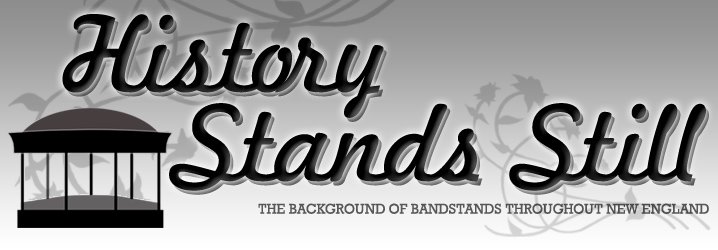BARRE MA
Harding Allen Memorial Bandstand
Barre Common
Built - 1931


The town of Barre is a small rural community located almost exactly in the center of the Commonwealth of Massachusetts. The community was originally dotted with many operating farms but as time went on, these farms became fewer leaving many unsown fields now in the area.
Therewas an old saying that "all roads lead to Barrre," during colonial times when the town had been an important stopover on the Old Stagecoach route which had connected central and western Massachusetts and parts of southern Vermont. This old saying still remains true today since there are still many scenic or commercial roads which pass through or near the town. The town was named after Colonel Isaac Bare who was one of the fiercest defenders of our American automony in the British Parliament.
During the Industrial Revolution, Barre became renowned for the production of farming equipment and palm leaf hats. During the Civil War, the town also did its part by supplying much of the gunpowder used by the Union Army.
Barre is built around a common area which its residents consider to be one of the loveliest in Central Massachusetts with band concerts being held for many years on the town's 2 past and 1 present bandstand structures. The town had the distinctive title of being "the band concert town of New England" due to its having these three bandstands during the past 130-odd years. Its first bandstand was a raised platform supported by four posts with no roof. The bandstand was approached by steep steps and was surrounded by patterned railings.
In 1882 the townspeople deemed the platform too high although it had served multiple purposes. Besides it being a stage for local bands, it was used as a pulpit for speeches and as a judge's stand during parades and cattle shows when fairs took place right on the common.
The townspeople then decided that a new bandstand be built which would provide protection for performers and add more charm to the common area. Funding for the new bandstand was done by public subscription but a few donations were withdrawn since a number of people objected to the placement of the new structure.
In keeping with the fashion of the day, the new bandstand was designed and built with a "pagoda roof" which, to this day, is used almost universally as the common style to be used.
This second bandstand stood proudly for more than forty years until public opinion indicated that the time was right for a replacement. A committee, the Barre Public Amusement Association - chaired by Mr. Martin Smith, was formed to discuss and initiate the building of a new and larger bandstand. At those meetings, it was decided that the bandstand would be a memorial to Mr. G. Harding Allen, one of the most prominent citizens of Barre, who had died the previous autumn.
Popular subscription was accomplished once again to fund this new bandstand keeping with an expression of community involvement. Interestingly, children of the town were urged to take part in the fund raising contributing quarters, dimes and nickels which would demonstrate their youthful importance to the community and as a learning experience in carrying out community projects.
A Boston architectural firm of Blackwell, Clapp, Whitman and Clark was selected to insure "a substantial, dignified bandstand" with the intent of having the structure designed and completed by the summertime. Slight delays interfered with the goal and the building contract was not warded until June. The E.J. Cross Company of Worcester was hired to construct the bandstand with the stipulation that Barre labor "shall be employed as far as possible." Also a further item to be dealt with was the fact that the commission required that the stonework base "match the ornamental stonewall bordering the Allen Estate" which was nearby within view across the street.
By late July of 1931, the bandstand was built and became the new centerpiece of the common with August 6th marking the dedication in memory of Harding Allen. The event was a huge one for the town and before noonon that day, automobiles were being parked in "best-view' places all around the common. The estimation by the beginning of the ceremonies was that over 2,000 cars were lined up on every street leading into town.
Doing the honors as the Master of Ceremonies was Mr. Robert G. Williams with the Reverend Michael Mulhane, pastor of St. Joseph's Church offering the main address. Their speeches were followed by brief remarks by town officers and the committee then a rousing concert was given by the famous Worcester Brass Band. All agreed that this fine new structure was a great example of "achievement through cooperation."
INFORMATION PROVIDED BY:
Linda J. Payne, Library Assistant
Woods Memorial Library, Barre

No comments:
Post a Comment